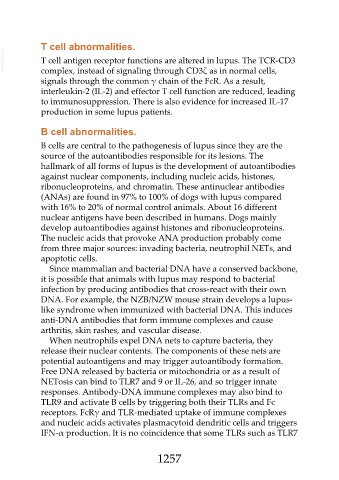Page 1257 - Veterinary Immunology, 10th Edition
P. 1257
T cell abnormalities.
VetBooks.ir T cell antigen receptor functions are altered in lupus. The TCR-CD3
complex, instead of signaling through CD3ζ as in normal cells,
signals through the common γ chain of the FcR. As a result,
interleukin-2 (IL-2) and effector T cell function are reduced, leading
to immunosuppression. There is also evidence for increased IL-17
production in some lupus patients.
B cell abnormalities.
B cells are central to the pathogenesis of lupus since they are the
source of the autoantibodies responsible for its lesions. The
hallmark of all forms of lupus is the development of autoantibodies
against nuclear components, including nucleic acids, histones,
ribonucleoproteins, and chromatin. These antinuclear antibodies
(ANAs) are found in 97% to 100% of dogs with lupus compared
with 16% to 20% of normal control animals. About 16 different
nuclear antigens have been described in humans. Dogs mainly
develop autoantibodies against histones and ribonucleoproteins.
The nucleic acids that provoke ANA production probably come
from three major sources: invading bacteria, neutrophil NETs, and
apoptotic cells.
Since mammalian and bacterial DNA have a conserved backbone,
it is possible that animals with lupus may respond to bacterial
infection by producing antibodies that cross-react with their own
DNA. For example, the NZB/NZW mouse strain develops a lupus-
like syndrome when immunized with bacterial DNA. This induces
anti-DNA antibodies that form immune complexes and cause
arthritis, skin rashes, and vascular disease.
When neutrophils expel DNA nets to capture bacteria, they
release their nuclear contents. The components of these nets are
potential autoantigens and may trigger autoantibody formation.
Free DNA released by bacteria or mitochondria or as a result of
NETosis can bind to TLR7 and 9 or IL-26, and so trigger innate
responses. Antibody-DNA immune complexes may also bind to
TLR9 and activate B cells by triggering both their TLRs and Fc
receptors. FcRγ and TLR-mediated uptake of immune complexes
and nucleic acids activates plasmacytoid dendritic cells and triggers
IFN-α production. It is no coincidence that some TLRs such as TLR7
1257

